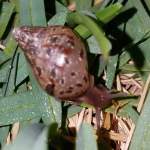SNAILS and SLUGS
Photos: Angela Liu
Arborists are concerned about land mollusks – snails, slugs, and semi-slugs – because ornamental woody plants provide hiding places for these pests. Tree seedlings, young leaves and tree fruit also provide forage for these gastropods.
Exotic snail species are introduced when plant materials (landscaping supplies, Christmas trees, etc.) are brought to Hawaii. Introduced land snail species (98 species introduced, 45 established) threaten already precarious populations of native land snail species. Nurseries also have been unintended reservoirs for invasive snails and slugs, which are introduced into new areas when infested tree stocks are planted out.
Disease Vectors: Diverse snail and slug species can host the nematode causing rat lungworm disease, Angiostrongylus cantonensis. A semislug (which has a small soft shell) Parmarion martensi has become more widespread, is much smaller and able to hide better, and carries twice the load of nematodes compared to other snails. The nematode itself is spreading globally – though infections are still relatively rare, the symptoms of this type of meningitis can be severe. Snails in certain areas on the Big Island have been found to be carriers, and it was reported that about 5% of snails and slugs on Oahu may carry the nematode.
Control: To get effective control against most species, use of a combination of methods as part of arboricultural practices.
• Pick snails and slugs near sundown – wear gloves, and remove or monitor hiding places, avoid frequent watering especially late in the day, and set traps by laying down slightly raised wooden boards that are checked regularly.
• Copper bands or screens, or a Bordeaux mixture can be used in limited areas to exclude snails.
• Beer in beer traps goes stale within days, and is not as effective as other methods.
• Iron-phosphate based baits are relatively safe for pets and wildlife.
• Bait containing metaldehyde should be kept away from aquatic organisms and domestic animals.
Always read and carefully follow labels for any pesticides you use.
Selected References:
-
Dresitadt, Steve H. Pests of Landscape Trees and Shrubs: An Integrated Pest Management Guide, 3rd University of California Agriculture and Natural Resources, 2016.
-
Hayes, Kenneth A., Invasive Land Snails of Hawaii, National Plant Diagnostic Network Malacology Workshop, UC Davis, June 16-18 2015 (Downloaded 09/30/2017). Downloaded 09/30/2017: https://www.npdn.org/system/files/WPDN%20Hayes_UC_Davis_Workshop_June_2015_HILS.pdf


